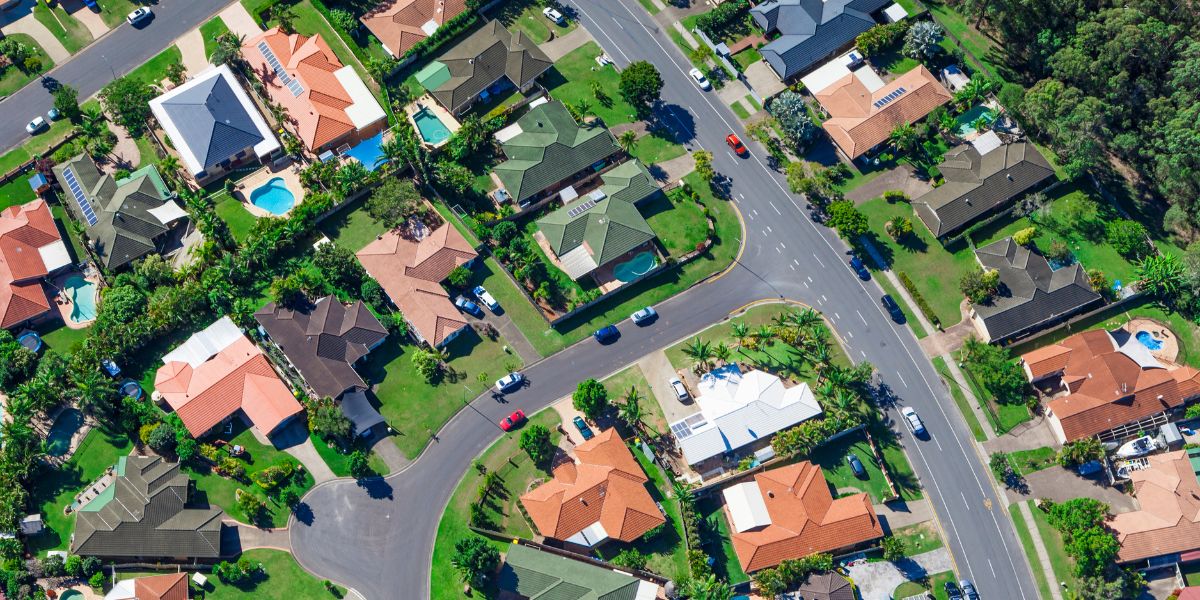24 May 2023
In 2006, Tourism Australia launched its $180 million advertising campaign, So where the bloody hell are you? But with temperatures in some parts of Australia forecast to rise by 4°C by 2050, it might be better to ask: “who will still be living here?”
The scenario of 2°C warming will be reached by 2030; we are already at 1.7°C. Every carbon molecule emitted stays in the atmosphere for 10,000 years, where they accumulate. Australia’s emissions per capita have remained amongst the highest of OECD countries. In 2020, Australia became the world’s largest LNG exporter and globally emissions have continued to rise. Despite its relatively small population, Australia makes a significant contribution to global emissions trends through its fossil fuel exports.
An optimistic 4°C scenario means that current winter temperatures will be a distant memory with expected temperatures consistently peaking at 40°C during winter. The question is not if we will be able to turn on the air conditioning to keep cool. Instead, it will be more existential questions of whether we can grow food and have secure supplies of water all year round. Money cannot buy food that does not grow anymore. The collapse of biodiversity and the ecosystems supporting our life are other major challenges.
In April, the federal government released a vehicle fuel efficiency standard plan as part of its National Electric Vehicle Strategy. While this is welcome news, it comes more than two decades after the EU introduced its car labelling directive in 1999. Australia must act urgently to catch up. Approving new coal mines and gas fields – business as usual – only pushes things in the wrong direction.
The limits of renewables
The 2022-23 Federal budget announced some investment to transition Australia’s energy sector. Many states are relying on a ramping-up of renewables to meet net zero commitments. However, a few things are missing in this picture. A coal fire plant cannot simply be replaced by solar panels and windmills of the same generating capacity. A coal or gas plant provides “qualitative” services that cannot be quantified, including flexibility in operation that is not possible with renewables.
Renewable electricity generation is not predictable, and in a changing climate extreme weather events will be more frequent. This simply increases risks associated with centralised energy generation: a model that has been in place for decades and continues to be the sole logic. South Australia’s experience last year illustrates this.
Failure to understand the limits of renewables leads to the wrong policies on all fronts. The wrong decision made today can continue to jeopardise our future. A solar panel produced through a coal-rich grid – such as in China which accounts for 95 per cent of the solar panel supply chain – will only offset its carbon footprint after 30 years of operation in Australia (i.e., the lifetime of the panel). Australia not only exported the intellectual property of the solar panel, but also subsidised the manufacturing overseas. In doing so, Australia lost the opportunity to drive our decarbonisation in meaningful ways by retaining expertise across the technologies we developed.
The massive ambition for renewable electrification across the states to meet the net zero target has also created the impression that Australia is on track. Yet, we do not have the storage capacity to firm renewables while closing existing coal plants. The 2022-23 budget committed $224.3 million for community batteries for up to 100,000 Australian households. But for every Australian household to be covered, the investment would need to be many magnitudes greater – and even then, this will not ensure that electricity is available around the clock given that batteries only have a storage capacity of a few hours. One of the largest batteries to be operational in 2026, the 350 MW Wooreen Energy Storage System, will be the first Australian four-hour battery, supporting 230,000 Victorian households. The Victoria population is 6.6 million and the typical life of a battery is seven years.
The Australian Energy Market Operator (AEMO) has predicted that by 2040 up to 19 GW of energy storage assets must be installed to replace the closing coal-fired plants and substitute renewables. Battery storage, pump hydro and natural gas are expected to be the solutions to firm renewables. However, with a changing climate it is not certain that there will be enough water to run dams. Meanwhile, gas is not a solution to decarbonise.
Australia’s (missed) hydrogen opportunity
We do, however, have a solution to efficiently store renewables: hydrogen. Unlike batteries, once generated hydrogen can be stored over long periods and distributed. This provides a unique opportunity to effectively store renewable energy. Hydrogen can be used to generate electricity and the heat needed in manufacturing. Like oil, hydrogen is also a precursor for making the chemicals we need, including for pharmaceuticals.
In 2019, there was excitement around hydrogen as the gas that would help Australia tap into its renewable assets and lead the country to a new export opportunity. Today, the hype has soured because of the realisation that hydrogen is expensive. Over the years, investment has not been made to develop the required technologies. The R&D hydrogen sector has remained dormant, despite expectations that technological advancements would roll out at the blink of an eye with the private sector grasping the opportunity. So, why hasn’t this happened?
First, the capability to develop and support hydrogen ecosystems is knowledge-based. Unlike natural gas, hydrogen is not something that can be dug out of the ground. Producing, storing and distributing hydrogen requires advanced expertise and skills that do not exist in the private sector. Second, there is no incentive for the private sector to take risks in advancing technologies that are not competitive. The new $2 billion in funding in the 2023-24 budget is trying to address this gap, but not before 2026-27. Third, unlike mining resources, provided one has access to the expertise and renewables, hydrogen can be produced anywhere. Australia does not have a natural advantage here. And in the meantime, economies like South Africa, Chile, the United States, the European Union and Japan are providing significant subsidies to their industry and funding their R&D sectors to support the deployment of green hydrogen projects at levels much more significant than currently possible in Australia. Finally, Australia has a very poor ecosystem for the translation of R&D. Deep tech innovation is extremely difficult, at the mercy of private investors and the market, with little chance to retain any local capability.
To date, hydrogen remains the main solution to help ramp-up renewables and decarbonise until we discover something better. Hydrogen is a synthetic energy carrier capable of displacing fossil fuels while having the same level of service. It also has the highest energy density of any fuel. It can be made from water and in turn creates water upon use, hence it is an ideal closed loop of emission-free energy. Hydrogen systems can also be decentralised to help build resilience. Nuclear power could provide a carbon-free source of electricity, but uranium is not a sustainable source of energy. Uranium reserves do not self-replenish, and uranium does not provide the qualitative services of oil or gas.
A market-based approach is also a very slippery strategy. We need to progress hydrogen not for the export opportunity but simply because of our moral obligation to preserve the future of Australia. This is a national security issue, where the private sector cannot deliver.
Catching up?
Achieving net zero means that we need to reduce our current carbon footprint per capita from the current staggering 41kg to 2kg of CO2 per day, per person to effectively reduce our emissions and limit the impact of climate change. Such a drastic reduction in emissions will not be met by simply building solar panels and having a minimalistic lifestyle. This calls for significant progress in economic and social models.
The impact of fossil fuels on climate was known since at least the 1980s. But the complexity of its implications calls for deep expertise, alternative polices, new strategies and models. Never before has society managed to transition from one energy system to another. We have only piled on new energy sources, adding oil, gas, nuclear and renewables on top of biomass and wood. In short, we need to imagine our future in a different climate.
So, what must be done for Australia to catch up?
Australian governments should put in place expert advisory panels, including from the university sector where the expertise exists, to understand the implications and develop a plan to transition and adapt the country. Australia should set research and innovation priorities to drive the technical solutions we need in this endeavour. This should lead to the mobilisation of expertise across the country to focus on developing the necessary technologies, but also the future economic and social models we need for a successful transition. In turn, a massive funding boost would support these activities as part of our national security, alongside strong incentives and subsidies to transition our industrial sectors. Accompanying this, think-tanks across the country could run public debates, educate people, and help promote the need for a national plan.
The task is complex, overwhelming and the scenario of climate “non-return” frightening – but inaction is even worse. As a society, we need to collectively develop our future.
Professor Kondo-Francois Aguey-Zinsou is based at the University of Sydney where he develops hydrogen technologies. He is director of H2potential a hydrogen advisory firm. He co-leads several international hydrogen research consortiums, and advises countries on their pathways to hydrogen.
Image credit: Cindy Shebley/Getty Images Signature
Features
Simon Rowell
Teddy Nagaddya, Jenna Condie, Sharlotte Tusasiirwe & Kate Huppatz
Subscribe to The Policymaker
Explore more articles
Teddy Nagaddya, Jenna Condie, Sharlotte Tusasiirwe & Kate Huppatz
Ehsan Noroozinejad Farsangi & Hassan Gholipour Fereidouni
Features
Simon Rowell
Teddy Nagaddya, Jenna Condie, Sharlotte Tusasiirwe & Kate Huppatz
Explore more articles
Teddy Nagaddya, Jenna Condie, Sharlotte Tusasiirwe & Kate Huppatz
Ehsan Noroozinejad Farsangi & Hassan Gholipour Fereidouni
Subscribe to The Policymaker








